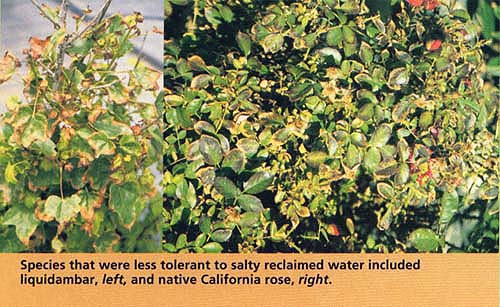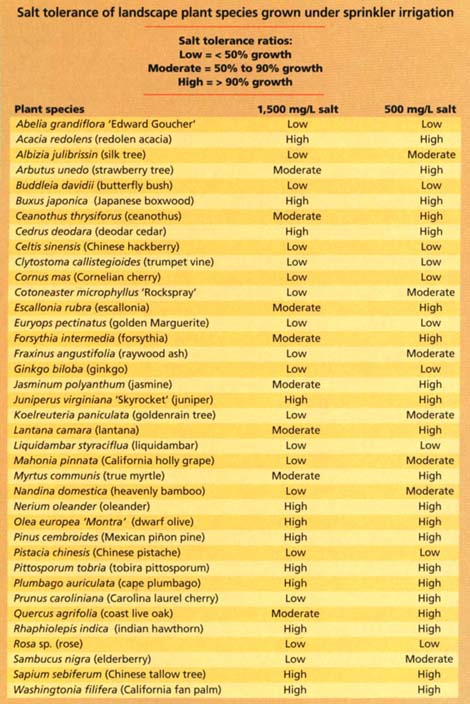All Issues
Salt tolerance of landscape species evaluated
Publication Information
California Agriculture 56(4):121-122.
Published July 01, 2002
PDF | Citation | Permissions
Full text
In recent decades, signs touting the use of reclaimed or recycled water have popped up in many urban settings where landscape plants are watered, such as highways, parks and golf courses. Yet surprisingly, landscape management professionals “don't have much guidance on how safe recycled water is for the plants,” says Lin Wu, UC Davis environmental horticulture professor.
The first wastewater treatment plant used solely for recycling water was built in San Francisco in 1932. Today, wastewater is recycled at more than 300 locations throughout California for agricultural and landscape irrigation, groundwater recharge and industrial uses. The California Water Resources Control Board estimates that by 2010, landscape irrigation will be the second largest use of reclaimed water, next to groundwater recharge.
After most water treatment processes, Wu says, salt (NaCl) is the only remaining constituent that is potentially detrimental to landscape plants. During the mid-1990s, several cities and counties approached the UC Davis environmental horticulture department to request field evaluations of the salt tolerance of landscape plants.
Reclaimed water is increasingly used to water land scaping in golf courses, public highways and parks.
In 1997, Wu, postgraduate researcher Xun Guo and Alameda County horticulture advisor Ali Harivandi initiated a series of studies. They grew common California landscape species in the field, containers and greenhouses; the plants were irrigated with water containing salt levels slightly above those found in most reclaimed waters, applied both by drip and sprinkler irrigation systems. The Elvenia J. Slosson Endowment Fund, Marin Municipal Water District and the city of San Jose supported the research program.
The properties of actual reclaimed water were provided by Marin Municipal Water District and South Bay Water Recycling of San Jose: average “real world” sodium concentrations range from about 160 milligrams per liter (mg/L) to 230 mg/L, and chloride ranges from 170 mg/L to 320 mg/L
Species that were less tolerant to salty reclaimed water included liquidambar, left, and native California rose, right.
Three salt levels were used in the studies: control (potable water containing about 80 mg/L sodium and 40 mg/L choride), low salt (500 mg/L salt) and high salt (1,500 mg/L). Plants were irrigated every third day with 1 inch of water.
For a nondestructive evaluation of salt stress responses, plant heights and canopy diameters were measured at the beginning and after 6 weeks of salt treatments. Visual symptoms such as chlorosis and leaf burn were recorded. Plant species were placed into three salt-tolerance categories for how well they grew (low, less than 50% growth; moderate, 50% to 90% growth; and high, greater than 90% growth).
All the plants irrigated by drip irrigation systems with either 500 mg/L or 1,500 mg/L salt exhibited normal growth, with most showing no foliar symptoms of salt stress. Apparently, the drip irrigation conducted by the study did not create soil salinity sufficient to induce salt stress in most of the plant species tested.
In California, however, “sprinkler irrigation is used for most landscape settings because it requires less maintenance and is less vulnerable to traffic,” Wu says. Under sprinkler irrigation with low-salt water (500 mg/L), 21 (56%) species were salt tolerant, 7 (81%) were moderately tolerant and 10 (26%) were salt sensitive. In irrigation with high-salt water (1,500 mg/L), 12 (32%) species were salt tolerant, 8 (21%) were moderately tolerant and 18 (47%) were salt sensitive (see table).
Some of the best-performing species included Japanese boxwood, oleander, juniper, dwarf olive, Mexican piñon pine and California an palm. Salt-sensitive species included rose, liquidambar, ginkgo and trumpet vine.
Wu says the studies found good agreement between the salt tolerance measured by actual plant growth and that measured by salt-stress symptoms. “The performance of landscape plants is judged by their appearance,” Wu says. “So the tolerance of leaves to salt-laden water is a critical trait for selecting plants to irrigate with reclaimed water.”
Demonstration gardens of landscape species irrigated with reclaimed water have been planted in San Jose and by the Marin County Water District. So far, no negative impacts on either the plants or the environment have been reported, Wu says.
The researchers recommend infrequent, heavy irrigation with reclaimed water, rather than frequent, light watering. Sprinkling should be done at night or in the early morning, and not on hot, dry, windy days. “Slowly rotating sprinklers that allow drying between cycles should be avoided as well,” Wu says.







